
The chachalacas, guans and curassows are birds in the family Cracidae. These are species of tropical and subtropical Central and South America. The range of one species, the plain chachalaca, just reaches southernmost parts of Texas in the United States. Two species, the Trinidad piping guan and the rufous-vented chachalaca occur on the islands of Trinidad and Tobago respectively.

The lineated woodpecker is a very large woodpecker which is a resident breeding bird from southern Mexico to northern Argentina and Trinidad in the Caribbean.
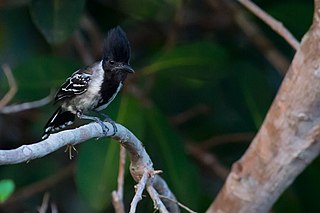
The black-crested antshrike is a passerine bird in subfamily Thamnophilinae of family Thamnophilidae, the "typical antbirds". It is found in tropical South America in Trinidad, Colombia, Venezuela, the Guianas, Brazil, and Peru.

The collared puffbird is a species of bird in the family Bucconidae, the puffbirds, nunlets, and nunbirds. It is found in Bolivia, Brazil, Colombia, Ecuador, French Guiana, Guyana, Peru, Suriname, and Venezuela.

Chachalacas are galliform birds from the genus Ortalis. These birds are found in wooded habitats in the far southern United States (Texas), Mexico, and Central and South America. They are social, can be very noisy and often remain fairly common even near humans, as their relatively small size makes them less desirable to hunters than their larger relatives. As agricultural pests, they have a ravenous appetite for tomatoes, melons, beans, and radishes and can ravage a small garden in short order. They travel in packs of six to twelve. Their nests are made of sticks, twigs, leaves, or moss and are generally frail, flat structures only a few feet above the ground. During April, they lay from three to five buffy white eggs, the shell of which is very rough and hard. They somewhat resemble the guans, and the two have commonly been placed in a subfamily together, though the chachalacas are probably closer to the curassows.
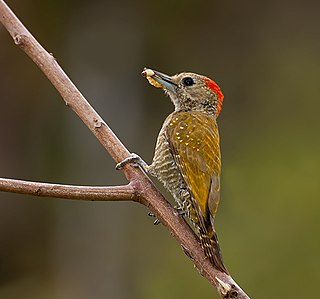
The little woodpecker is a species of bird in subfamily Picinae of the woodpecker family Picidae. It is found in every mainland South American country except Chile, Suriname, and Uruguay.

The black-eared fairy is a species of hummingbird in the subfamily Polytminae, the mangoes. It is found in every mainland South American country except Argentina, Chile, Paraguay, and Uruguay.

The yellow-green grosbeak is a species of grosbeak in the family Cardinalidae.
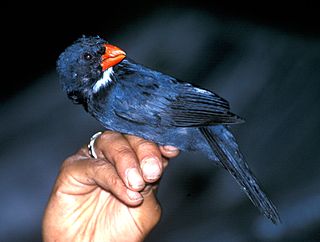
The slate-coloured grosbeak is a species of grosbeak in the family Thraupidae. Most of its range is the Amazon in South America, but it is also found in forests of the Chocó in Ecuador and Colombia, and southern Central America from Panama to Honduras.

The chestnut-winged chachalaca is a species of bird in the family Cracidae, the chachalacas, guans, and curassows. It is endemic to Colombia.

The speckled chachalaca is a species of bird in the family Cracidae, the chachalacas, guans, and curassows. It is found in Bolivia, Brazil, Colombia, Ecuador, and Peru.

The buff-browed chachalaca is a species of bird in the family Cracidae, the chachalacas, guans, and curassows. It is endemic to Brazil.
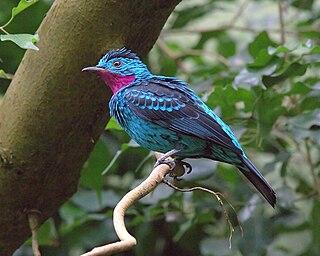
The spangled cotinga is a species of bird in the family Cotingidae, the cotingas. It is found in the canopy of the Amazon Rainforest in South America.

The black-capped donacobius is a conspicuous, vocal South American bird. It is distributed across the northern half of South America.

The rusty-margined flycatcher is a species of bird in the family Tyrannidae, the tyrant flycatchers.
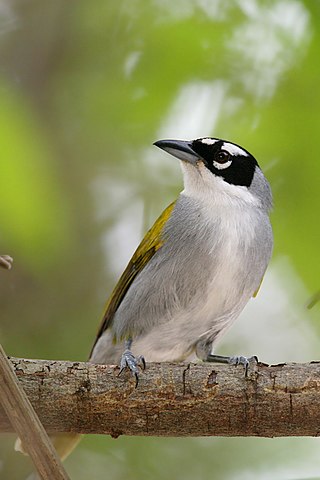
The black-crowned palm-tanager or black-crowned tanager is a species of bird of the family Phaenicophilidae, the Hispaniolan palm-tanagers. It is endemic to the island of Hispaniola which is shared by Haiti and the Dominican Republic.

The spotted tanager is a species of bird in the tanager family Thraupidae. It is found in Bolivia, Brazil, Ecuador, French Guiana, Guyana, Peru, Suriname, and Venezuela. Its natural habitats are subtropical or tropical moist lowland forests and subtropical or tropical moist montane forests.

The East Brazilian chachalaca is a species of bird in the family Cracidae, the chachalacas, guans, and curassows. It is endemic to eastern Brazil.
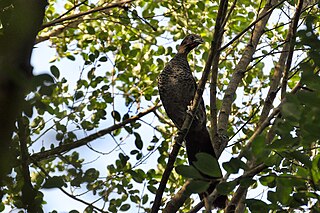
The scaled chachalaca is a species of bird in the family Cracidae, the chachalacas, guans, and curassows. It is endemic to Brazil.

The chestnut-headed chachalaca is a bird in the family Cracidae, the chachalacas, guans, and curassows. It is endemic to Brazil.























